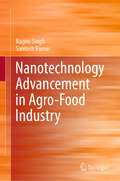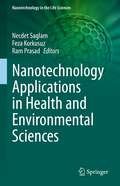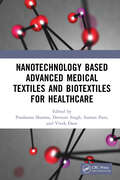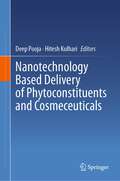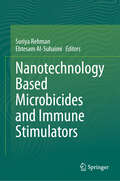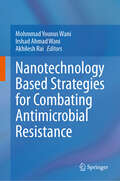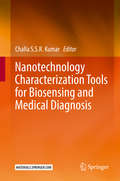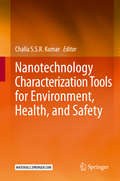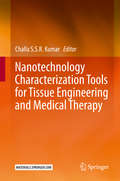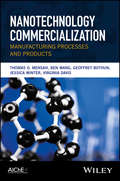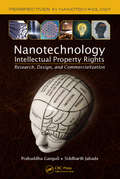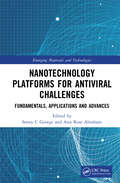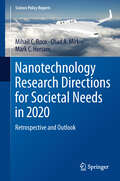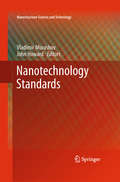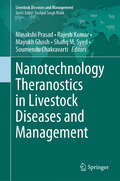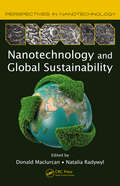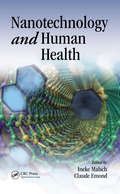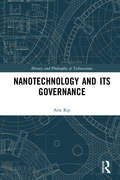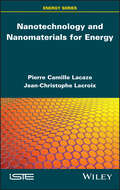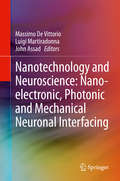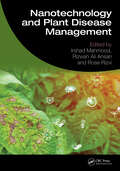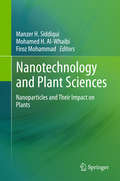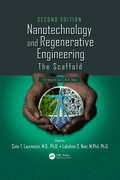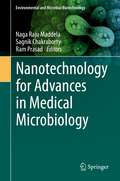- Table View
- List View
Nanotechnology Advancement in Agro-Food Industry
by Santosh Kumar Ragini SinghThis book provides a comprehensive insight into the growth of nanotechnology in the agri-food industry. Currently, nanotechnology serves as the most promising means to resolve the issues encountered in the food sector, as it enables the production of high-quality food with exceptional characteristics such as extended shelf life, flavor, freshness, and high nutritional content. This book focuses on the applications of nanotechnology in various fields such as smart packaging, processing, and preservation of food. It also emphasizes the role of nanomaterials in strategic design of nutraceuticals and functional foods. Along with providing an overview of the innovations and application, this book also describes future perspectives, and offers insights to ensure consumer confidence in terms of safe use. In this context the application of nanomaterials as nanosensors is additional covered. The book provides readers with a deep knowledge regarding nanomaterials-based biosensors (colorimetric, electrochemical, fiber-based) for detection of pathogens in contaminated food. Factors affecting risk assessment regulations and safety concerns regarding the use of nanomaterials in food industry have also been discussed in detail. Given its scope, this book appeals to a wider readership, especially for researchers and students who work in food agronomy and nanomaterials and nanotechnology related fields.
Nanotechnology Applications in Health and Environmental Sciences (Nanotechnology in the Life Sciences)
by Feza Korkusuz Ram Prasad Necdet SaglamNanoscience and nanotechnologies are leading to a major point to our understanding of nature. Nanotechnology can be generally defined as creation and use of nano-sized systems, devices, and structures which have special functions or properties because of their small size. This volume on Nanotechnology Applications in Health and Environmental Sciences focuses on biotechnological and environmental applications of nanomaterials. It covers popular and various nanomedical topics such as oncology, genetics, and reconstructive medicine. Additionally, many chapters give leading-edge information on nano-sensor applications and usage in specific disciplines. Also, two chapters on novel subjects have been included on Lantibiotics and microbiota. This book should be useful for nanotechnologists, microbiologists, and researchers interested in nanomedicine and nano-biotechnology, as well as environmental nanotechnology.
Nanotechnology Based Advanced Medical Textiles and Biotextiles for Healthcare
by Vivek Dave Prashansa Sharma Devsuni Singh Suman PantThis book provides systematic coverage of research into medical and biotextiles based on nanomaterials as applicable in healthcare. Divided into three sections, it explains manufacturing, properties, types, and recent developments in nanotechnology based medical textiles backed by case studies. It includes a wide range of different clinical applications of biotextiles for healthcare including nanotextile scaffolds, nano-based artificial organs, surgical sutures, enzymatic assisted enhanced biotextiles, tissue engineering or drug delivery system via nanofibers, and so forth.Features: Provides strong and broad overview of medical applications in the field of nano and biotextiles. Highlights different approaches, recent research, and emerging innovations. Covers designing or developing nanomaterials based antiviral surface disinfectants with self-cleaning property. Reviews different applications of nano based medical textiles such as deodorizing or pH control clothing for hygiene maintenance. Includes the real-life applications based descriptive case studies that offer a diverse range of perspectives. This book is aimed at researchers and graduate students in textile technology and engineering, and medical textiles.
Nanotechnology Based Delivery of Phytoconstituents and Cosmeceuticals
by Deep Pooja Hitesh KulhariThis book explores the role of nanotechnology in the delivery of natural phytoconstituents and cosmeceuticals. It presents polymeric nanocarriers, lipid-based nanocarriers, metal/metal oxide nanocarriers, protein nanocarriers, and dendrimers for the delivery of phytoconstituents. Further, it focuses on the usage of phytocompounds in various cosmeceutical products and nano delivery technologies used in the delivery of various cosmeceuticals. Finally, the book reviews the toxicity issues of nanoparticles in the delivery of phytoconstituents and cosmeceuticals and regulatory aspects for clinical applications of nano phytomedicines. This book is helpful for academicians and researchers working in pharmaceutical sciences, nano science, material science, plant science, and cosmetic science.
Nanotechnology Based Microbicides and Immune Stimulators
by Suriya Rehman Ebtesam Al-SuhaimiThis book reviews the use of nano-based drug delivery systems and biomaterials to enhance the immune system against infectious diseases. It focusses on the inbuilt immunoreactive properties of nanomaterials and the advancement in its engineering to modulate the immune system either via immune-stimulation or immunosuppression. The book further discusses the use of nanoparticle-based vaccines to improve vaccine efficacy, immunization strategies, and targeted delivery to achieve desired immune responses at the cellular level against infectious diseases. Perhaps, book focusses on nanoscale diagnostics that offer new approaches for sensitive health monitoring that are potable and can guide the use of nanoscale therapies. This book explores the potential of immunomodulatory nanotechnologies, focusing not only on their benefits, but also on biocompatibility, and toxicity concerns, while highlighting promising innovations in Interferon-based immune therapies and addressing key challenges in achieving safe, scalable nanotech products. The book would encompass broad topics to attract the diverse specialty of physicians, health professionals, students, faculty, and researchers of nanotechnology, nanomedicine, infectious diseases, public health, immunology, bacteriology, virology, pathology, biotechnology, toxicology, and biomedical technology.
Nanotechnology Based Strategies for Combating Antimicrobial Resistance
by Mohmmad Younus Wani Irshad Ahmad Wani Akhilesh RaiThis book provides a comprehensive overview of recent advances in nanotechnology as an alternative strategy for addressing antimicrobial resistance (AMR). Examining nanotechnology-based methods such as nanoencapsulation, drug delivery, and conjugation, the text highlights their successful application in treating microbial infections with reduced resistance and off-target toxicity. The introductory section outlines AMR and explores diverse mechanisms of microbial resistance, emphasizing the potential of nanotechnology to surmount these challenges. Subsequent chapters investigate the role of specific nanomaterials—metal nanoparticles, metal oxide nanoparticles, functionalized quantum dots, magnetic nanoparticles, bimetallic nanoparticles, nanocomposites, carbon nanomaterials, and polymer-based nanomaterials—in overcoming antimicrobial resistance. Several chapters focus on the efficacy of nanoemulsions as an antimicrobial delivery method, underscoring their inherent antimicrobial properties, capacity to enhance drug solubility, stability, bioavailability, and targeting potential at the organ and cellular levels. The concluding section provides a detailed review of liposomes, dendrimers-based nanoparticles, and micelles as drug delivery vehicles in the context of combating pathogens resistant to antimicrobials.
Nanotechnology Characterization Tools for Biosensing and Medical Diagnosis
by Challa S.S.R. KumarEighth volume of a 40 volume series on nanoscience and nanotechnology, edited by the renowned scientist Challa S.S.R. Kumar. This handbook gives a comprehensive overview about Nanotechnology Characterization Tools for Biosensing and Medical Diagnosis. Modern applications and state-of-the-art techniques are covered and make this volume an essential reading for research scientists in academia and industry.
Nanotechnology Characterization Tools for Environment, Health, and Safety
by Challa S. S. R. KumarTenth volume of a 40 volume series on nanoscience and nanotechnology, edited by the renowned scientist Challa S.S.R. Kumar. This handbook gives a comprehensive overview about Nanotechnology Characterization Tools for Environment, Health, and Safety. Modern applications and state-of-the-art techniques are covered and make this volume an essential reading for research scientists in academia and industry.
Nanotechnology Characterization Tools for Tissue Engineering and Medical Therapy
by Challa S. S. R. KumarNinth volume of a 40 volume series on nanoscience and nanotechnology, edited by the renowned scientist Challa S.S.R. Kumar. This handbook gives a comprehensive overview about Nanotechnology Characterization Tools for Tissue Engineering and Medical Therapy. Modern applications and state-of-the-art techniques are covered and make this volume an essential reading for research scientists in academia and industry.
Nanotechnology Commercialization: Manufacturing Processes and Products
by Jessica Winter Thomas O. Mensah Ben Wang Geoffrey Bothun Virginia DavisA fascinating and informative look at state-of-the-art nanotechnology research, worldwide, and its vast commercial potential Nanotechnology Commercialization: Manufacturing Processes and Products presents a detailed look at the state of the art in nanotechnology and explores key issues that must still be addressed in order to successfully commercialize that vital technology. Written by a team of distinguished experts in the field, it covers a range of applications notably: military, space, and commercial transport applications, as well as applications for missiles, aircraft, aerospace, and commercial transport systems. The drive to advance the frontiers of nanotechnology has become a major global initiative with profound economic, military, and environmental implications. Nanotechnology has tremendous commercial and economic implications with a projected $ 1.2 trillion-dollar global market. This book describes current research in the field and details its commercial potential—from work bench to market. Examines the state of the art in nanotechnology and explores key issues surrounding its commercialization Takes a real-world approach, with chapters written from a practical viewpoint, detailing the latest research and considering its potential commercial and defense applications Presents the current research and proposed applications of nanotechnology in such a way as to stimulate further research and development of new applications Written by an all-star team of experts, including pioneer patent-holders and award-winning researchers in nanotechnology The major challenge currently faced by researchers in nanotechnology is successfully transitioning laboratory research into viable commercial products for the 21st century. Written for professionals across an array of research and engineering disciplines, Nanotechnology Commercialization: Manufacturing Processes and Products does much to help them bridge the gap between lab and marketplace.
Nanotechnology Intellectual Property Rights: Research, Design, and Commercialization (Perspectives in Nanotechnology #8)
by Prabuddha Ganguli Siddharth Jabade"We need to seamlessly integrate IPR in the standard graduate/post graduate courses in science, technology, commerce, creative arts, etc., without over burdening the students with law"—Dr Prabuddha Ganguli, CEO, VISION-IPRNanotechnology Intellectual Property Rights: Research, Design, and Commercialization offers an overview of the dynamics of development and commercialization in nanotech, where strategic integration of IP, R&D, and commercialization has become imperative. It demystifies issues of intellectual property rights (IPR) associated with research, design, technology transfer, and commercialization of innovations in technology-led areas such as nanotech. Gives all stakeholders vital information to instill confidence by helping them better understand their individual roles in the IPR process Designed for a diverse readership that may not have background knowledge of the legal nuances of IPR, this book clearly articulates techno-legal aspects of nano-related innovations to aid their effective integration into businesses. This resource stands apart by using numerous case studies and pictorial illustrations, addressing aspects ranging from ideation to commercialization of IP-enabled nanotechnology. It illustrates the evolving patent landscape in nanotechnology, explores the international patent classification system, and details patenting procedures in a range of jurisdictions, including search for nanotechnology prior art and creation of search strategies. The authors discuss patent-led nanotechnology businesses, presenting a wide range of case studies that address construction of valuable patent portfolios, growth of start-ups, and consolidation of IP-led nanobusinesses through mergers, acquisitions, joint ventures, strategic investments, etc. They also cover patent litigations in nanotechnologies and the significance of strategically crafting agreements related to IP transactions. In addition, they address compliance with contractual obligations, the importance of well-drafted patent specifications, and sensitive aspects of conducting techno-legal due diligence prior to the development and marketing of products. Also covered are vulnerabilities in challenging/defending the validity of patents and negotiating settlements. Integrating use of the IPRinternalise® model for capacity building in human and infrastructural resources, the authors assess the future of IP landscaping in nanotechnology. Here, they focus on patentability, public perception of risks to health and ecosystems, institutionalized management of intellectual property rights, and the steps that will be necessary to meet these and other such challenges on the way to realizing profits in nanotech.
Nanotechnology Platforms for Antiviral Challenges: Fundamentals, Applications and Advances (Emerging Materials and Technologies)
by Soney C George and Ann Rose AbrahamNanotechnology provides an innovative platform for drug delivery and antiviral actions. This book discusses the utilization of nano-based formulations for the control of viral agents. The antiviral potential of green synthesized silver, chitosan nanoparticles encapsulating curcumin, photoinduced antiviral carbon nanohorns, and the role of carbon-based materials like fullerenes, and carbon nanotubes in the repression of viral antigens are explained. The book also covers nanomaterial-based solutions for SARS-CoV-2 and other viral infections. Features: Explains theory and practical applications of nanomaterials as antiviral agents. Reviews upscaling of nanomaterials from laboratory to fabrication stage. Illustrates nanocurcumin, silver nanoparticles, and carbon nanoparticles for biomedical applications. Highlights role of nanotechnology in effectively combating viral infections and pandemics. Includes case studies of specific pharma companies. This book is aimed at researchers, graduate students in materials science, microbiology and virology, and pharmaceutical sciences.
Nanotechnology Research Directions for Societal Needs in 2020
by Chad A. Mirkin Mihail C. Roco Mark C. HersamThis volume presents a comprehensive perspective on the global scientific, technological, and societal impact of nanotechnology since 2000, and explores the opportunities and research directions in the next decade to 2020. The vision for the future of nanotechnology presented here draws on scientific insights from U.S. experts in the field, examinations of lessons learned, and international perspectives shared by participants from 35 countries in a series of high-level workshops organized by Mike Roco of the National Science Foundation (NSF), along with a team of American co-hosts that includes Chad Mirkin, Mark Hersam, Evelyn Hu, and several other eminent U.S. scientists. The study performed in support of the U.S. National Nanotechnology Initiative (NNI) aims to redefine the R&D goals for nanoscale science and engineering integration and to establish nanotechnology as a general-purpose technology in the next decade. It intends to provide decision makers in academia, industry, and government with a nanotechnology community perspective of productive and responsible paths forward for nanotechnology R&D.
Nanotechnology Standards
by John Howard Vladimir MurashovWritten by a team of experts, Nanotechnology Standards provides the first comprehensive, state-of-the-art reviews of nanotechnology standards development, both in the field of standards development and in specific areas of nanotechnology. It also describes global standards-developing processes for nanotechnology, which can be extended to other emerging technologies. For topics related to nanotechnology, the reviews summarize active areas of standards development, supporting knowledge and future directions in easy-to-understand language aimed at a broad technical audience. This unique book is also an excellent resource for up-to-date information on the growing base of knowledge supporting the introduction of nanotechnology standards and applications into the market.
Nanotechnology Theranostics in Livestock Diseases and Management (Livestock Diseases and Management)
by Rajesh Kumar Minakshi Prasad Mayukh Ghosh Shafiq M. Syed Soumendu ChakravartiThis book reviews various applications of nanotechnology in the prophylactic, diagnostic, and therapeutic management of livestock diseases. The initial section discusses the strategies for the synthesis of nanomaterials and characterization of different nanomaterials. The subsequent chapters explore the role of nanoparticles in the diagnosis of diseases caused by pathogenic microorganisms, including bacteria, viruses, protozoans, and fungi. The book also examines the nano sensors that are used for point-of-care diagnosis of various livestock diseases. Additionally, it highlights nanoparticles-based vaccines and vaccine delivery systems to combat bacterial livestock diseases. Lastly, the book entails the strategies for developing nanotherapeutics for the treatment of bacterial, viral, fungal diseases, metabolic disorders, and cancer in livestock animals. The content of this book is useful for researchers and practitioners interested in understanding the applications of nanotechnology in diagnostics and therapeutics of livestock diseases.
Nanotechnology and Global Sustainability (Perspectives in Nanotechnology)
by Donald Maclurcan Natalia RadywylThe rise of collaborative consumption, peer-to-peer systems, and not-for-profit social enterprise heralds the emergence of a new era of human collectivity. Increasingly, this consolidation stems from an understanding that big-banner issues—such as climate change—are not the root causes of our present global predicament. There is a growing and collective view that issues such as this are actually symptoms of a much more vicious, seemingly insurmountable condition: our addiction to economic, consumption, and population growth in a world of finite resources. Nanotechnology and Global Sustainability uses nanotechnology—the product of applied scientific knowledge to control and utilize matter at atomic and molecular scales—as a lens through which to explore the interrelationship between innovation, politics, economy, and sustainability. This groundbreaking book addresses how stakeholders can actively reshape agendas to create positive and sustainable futures through this latest controversial, cross-sectoral technology. It moves beyond issues of efficiency, productivity, and utility, exploring the insights of 22 contributors from around the world, whose work spans the disciplines of science and the humanities. Their combined knowledge, reinforced with various case studies, introduces an exciting prospect—how we can innovate without economic growth. This new volume in the Perspectives in Nanotechnology series is edited by Dr. Donald Maclurcan and Dr. Natalia Radywyl. Dr. Maclurcan is a social innovator and Honorary Research Fellow with the Institute for Nanoscale Technology at the University of Technology Sydney, Australia. Dr. Radywyl is a social researcher and Honorary Research Fellow in the School of Culture and Communication at the University of Melbourne, Australia. She is also an Adjunct Research Fellow in the Faculty of Life and Social Sciences at Swinburne University of Technology, Melbourne. This book is written for a wide audience and will be of particular interest to activists, scholars, policy makers, scientists, business professionals, and others who seek an understanding of how we might justly transition to sustainable societies.
Nanotechnology and Human Health
by Paul C. H. LiAddressing medium- and long-term expectations for human health, this book reviews current scientific and technical developments in nanotechnology for biomedical, agrofood, and environmental applications. This collection of perspectives on the ethical, legal, and societal implications of bionanotechnology provides unique insight into contemporary te
Nanotechnology and Its Governance (History and Philosophy of Technoscience)
by Arie RipThis book charts the development of nanotechnology in relation to society from the early years of the twenty-first century. It offers a sustained analysis of the life of nanotechnology, from the laboratory to society, from scientific promises to societal governance, and attempts to modulate developments.
Nanotechnology and Nanomaterials for Energy
by Pierre-Camille Lacaze Jean-Christophe LacroixThe major topical and societal issues of energy transition and environmental conservation have benefited from the contribution of nanotechnologies and nanomaterials. Nanomaterials, including carbon-based newcomers, have helped to improve in particular the performance of energy storage and conversion devices. Some of these nanomaterials, including fullerenes, carbon nanotubes, nanodiamonds and carbon dots, were discovered well before the 2000s. Others are more recent, including graphene (the leading material of the 21st century) as well as many mineral materials developed at the nano scale: atomic clusters, metal or semiconductor nanoparticles, two-dimensional inorganic materials, metal-organic frameworks (MOF) and luminescent quantum dots. All of these are involved in the realization of devices for energy purposes. Nanotechnology and Nanomaterials for Energy provides a critical analysis of the latest work in the fields of batteries, photovoltaics, fuel cells and catalysis as well as lighting, with the advent of light-emitting diodes.
Nanotechnology and Neuroscience: Nano-electronic, Photonic and Mechanical Neuronal Interfacing
by Massimo De Vittorio Luigi Martiradonna John AssadThis book describes the use of modern micro- and nanofabrication technologies to develop improved tools for stimulating and recording electrical activity in neuronal networks. It provides an overview of the different ways in which the "nano-world" can be beneficial for neuroscientists, including improvement of mechanical adhesion of cells on electrodes, tight-sealed extracellular recordings or intracellular approaches with strongly reduced invasiveness and tools for localized electrical or optical stimulation in optogenetics experiments. Specific discussion of fabrication strategies is included, to provide a comprehensive guide to develop micro and nanostructured tools for biological applications. A perspective on integrating these devices with state-of-the-art technologies for large-scale in vitro and in vivo experiments completes the picture of neuronal interfacing with micro- and nanostructures.
Nanotechnology and Plant Disease Management
by Rizwan Ali Ansari Irshad Mahmood Rose RizviNanotechnology and Plant Disease Management explores the intersection of nanotechnology and agriculture. This book serves as a comprehensive exploration of the current state and future potential of nanoparticles in revolutionizing plant disease management within the realm of agriculture. This book elucidates the synthesis, characterization and judicious application of nanoparticles, providing a clear and accessible explanation of what nanomaterials are, how they are characterized, and their pivotal role in reshaping the plant disease management systems. It scrutinizes innovative strategies that influence the unique properties of nanoparticles to identify and monitor the presence of pathogens at early stages. The book also examines the limitations inherent in the use of nanomaterials for disease management in plants by critically evaluating both sides of the spectrum. This aims to provide a candid overview of the hurdles that must be overcome to unlock the full benefits of nanotechnology in this field. By pinpointing and understanding these obstacles, the current work aims to pave the way for effective strategies and solutions, ensuring the responsible and optimized application of nanomaterials for enhanced plant disease management. This in-depth examination serves as a cornerstone, providing readers with a profound understanding of the intricate processes involved in synthesis, characterization and utilizing nanomaterials for disease control. Nanotechnology and Plant Disease Management is a testament to the transformative potential of nanotechnology in agriculture. The authors invite readers to embark on this enlightening journey, exploring the intricate world of nanomaterials and their application in safeguarding the health and vitality of plants.
Nanotechnology and Plant Sciences
by Firoz Mohammad Manzer H. Siddiqui Mohamed H. Al-WhaibiThis book presents a holistic view of the complex and dynamic responses of plants to nanoparticles, the signal transduction mechanisms involved, and the regulation of gene expression. Further, it addresses the phytosynthesis of nanoparticles, the role of nanoparticles in the antioxidant systems of plants and agriculture, the beneficial and harmful effects of nanoparticles on plants, and the application of nanoparticles and nanotubes to mass spectrometry, aiming ultimately at an analysis of the metabolomics of plants. The growing numbers of inventions in the field of nanotechnology are producing novel applications in the fields of biotechnology and agriculture. Nanoparticles have received much attention because of the unique physico-chemical properties of these compounds. In the life sciences, nanoparticles are used as "smart" delivery systems, prompting the Nobel Prize winner P. Ehrlich to refer to these compounds as "magic bullets. " Nanoparticles also play an important role in agriculture as compound fertilizers and nano-pesticides, acting as chemical delivery agents that target molecules to specific cellular organelles in plants. The influence of nanoparticles on plant growth and development, however, remains to be investigated. Lastly, this book reveals the research gaps that must be bridged in the years to come in order to achieve larger goals concerning the applications of nanotechnology in the plants sciences. In the 21st century, nanotechnology has become a rapidly emerging branch of science. In the world of physical sciences, nanotechnological tools have been exploited for a broad range of applications. In recent years, nanoparticles have also proven useful in several branches of the life sciences. In particular, nanotechnology has been employed in drug delivery and related applications in medicine.
Nanotechnology and Regenerative Engineering: The Scaffold, Second Edition
by Cato T. Laurencin M. Phil. Lakshmi S. NairNanotechnology and regenerative engineering have emerged to the forefront as the most versatile and innovative technologies to foster novel therapeutic techniques and strategies of the twenty-first century. The first edition of Nanotechnology and Tissue Engineering: The Scaffold was the first comprehensive source to explain the developments in nano
Nanotechnology and the Generation of Sustainable Hydrogen (Green Energy and Technology)
by Sarah Farrukh Xianfeng Fan Kiran Mustafa Arshad Hussain Muhammad Ayoub Mohammad YounasThis book explains the aspiring vision of a sustainable hydrogen generating system which employs nanotechnology one way or the other and presents a detailed update on research activities, achievements and challenges. It explores how nanotechnology is reshaping science in general and how this can be applied to the generation and storage of hydrogen energy. This book begins by highlighting the importance of hydrogen a source of sustainable energy and its impact on the technical advances of fuel cells, internal combustion engines, batteries and power plants. The book depicts the role of nanotechnology in the development of sustainable hydrogen. Comprehensive studies on various nanotechnologies involved in hydrogen generation are discussed in separate chapters, representing a complete picture of hydrogen generation utilizing nanotechnology. This book serves as a useful research tool for academics and practitioners looking towards new ways to develop and consume energy, without conceding our environment. Providing the advantages and disadvantages of each technology discussed, this book shows the benefits of utilizing nanotechnology in this field.
Nanotechnology for Advances in Medical Microbiology (Environmental and Microbial Biotechnology)
by Naga Raju Maddela Ram Prasad Sagnik ChakrabortyCombined fields of Microbiology and Nanotechnology have been most successful in providing novel solutions for protecting the health of humans and environment. This book covers the implications of nano-strategies to combat bacterial pathogens, applications of nanotechniques in microbiology, and innovative advances in the area of medical microbiology. Contents are divided into three sections -- Nanoscience in controlling bacterial pathogens, Nanoscience in Microbiology, Medical Microbiology. This volume is going to provide timely information about the technological advances of Nanoscience in the domain of Microbiology, with a special emphasis on Pathobiology. The book is a useful read for students and researchers in microbiology, nanotechnology and medical microbiology.
